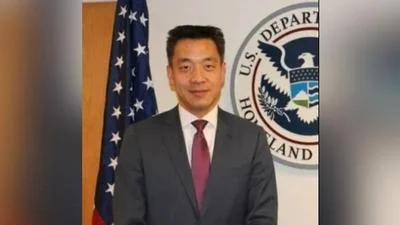The publication is reproduced in full below:
CHIEF STANDING BEAR NATIONAL HISTORIC TRAIL FEASIBILITY STUDY
Mr. SOTO. Madam Speaker, I move to suspend the rules and pass the bill (H.R. 810) to amend the National Trails System Act to direct the Secretary of the Interior to conduct a study on the feasibility of designating the Chief Standing Bear National Historic Trail, and for other purposes.
The Clerk read the title of the bill.
The text of the bill is as follows:
H.R. 810
Be it enacted by the Senate and House of Representatives of the United States of America in Congress assembled,
SECTION 1. CHIEF STANDING BEAR NATIONAL HISTORIC TRAIL
FEASIBILITY STUDY.
Section 5(c) of the National Trails System Act (16 U.S.C. 1244(c)) is amended by adding at the end the following:
``(xx) Chief standing bear national historic trail.--The Chief Standing Bear Trail, extending approximately 550 miles from Niobrara, Nebraska, to Ponca City, Oklahoma, which follows the route taken by Chief Standing Bear and the Ponca people during Federal Indian removal, and approximately 550 miles from Ponca City, Oklahoma, through Omaha, Nebraska, to Niobrara, Nebraska, which follows the return route taken by Chief Standing Bear and the Ponca people.''.
The SPEAKER pro tempore. Pursuant to the rule, the gentleman from Florida (Mr. Soto) and the gentleman from Arkansas (Mr. Westerman) each will control 20 minutes.
The Chair recognizes the gentleman from Florida.
General Leave
Mr. SOTO. Madam Speaker, I ask unanimous consent that all Members may have 5 legislative days in which to revise and extend their remarks and include extraneous material on the measure under consideration.
The SPEAKER pro tempore. Is there objection to the request of the gentleman from Florida?
There was no objection.
Mr. SOTO. Madam Speaker, I yield myself such time as I may consume.
Madam Speaker, H.R. 810, introduced by Representative Fortenberry from Nebraska, would direct the Secretary of the Interior to conduct a study on the feasibility of designating the Chief Standing Bear National Historic Trail.
The proposed trail would extend approximately 550 miles from Niobrara, Nebraska, to Ponca City, Oklahoma, tracing the route taken by Chief Standing Bear and the Ponca people during Federal Indian removal and their return to Nebraska.
The trail would commemorate and elevate the story of Chief Standing Bear, including the trial and historic 1879 court case where he became the first Native American to be recognized as a person in a Federal court.
The trail would memorialize the courage, honor, and fortitude of Chief Standing Bear and the Ponca people as they struggled to return to their homeland to bury the son of Chief Standing Bear--serving as a reminder of their fight to achieve justice, freedom, and equality.
I would like to thank Representative Fortenberry for championing this important legislation and for his efforts to bring about a greater understanding of our U.S. history and Tribal sovereignty.
Madam Speaker, I urge my colleagues to support this good bipartisan bill, and I reserve the balance of my time.
{time} 1345
Mr. WESTERMAN. Madam Speaker, I yield myself such time as I may consume.
Madam Speaker, I thank the majority for the bipartisan support on this good piece of legislation.
H.R. 810, authored by our colleague from Nebraska, Congressman Fortenberry, directs the Secretary of the Interior to study the feasibility of designating the Chief Standing Bear National Historic Trail.
Chief Standing Bear of the Ponca Tribe is one of Nebraska's most important historical figures and is honored here in the Capitol as one of Nebraska's contributions to the National Statuary Hall Collection.
Chief Standing Bear led his people through a crisis that began with its displacement by droves of westward-bound settlers. The Ponca Tribe moved twice in search of new land but had no success. Finally, in 1877, the U.S. Government forced their relocation.
By 1878, when they reached their destination in Oklahoma's Indian Territory, starvation and disease had claimed almost a third of the Tribe. Among the dead was Bear Shield, the first son of Standing Bear.
Standing Bear's desire to honor his son's wish that he be buried in his Nebraska birthplace, at a time when Native Americans could not legally leave their reservations without government permission, led to the trial for which he is best remembered today. The case established that Native Americans were persons under the law and are entitled to the same rights as anyone else in the Nation. During that case, the words of Chief Standing Bear, pleading on behalf of his Tribe, moved the Nation.
The Chief Standing Bear Trail, extending approximately 550 miles from Nebraska to Oklahoma, follows the route taken by Chief Standing Bear and the Ponca people during Federal Indian removal. If supported by the study, any designation of the trail would require additional action from the Natural Resources Committee and the Congress.
Madam Speaker, I urge adoption of the measure, and I reserve the balance of my time.
Mr. SOTO. Madam Speaker, I have no further requests for time, and I reserve the balance of my time.
Mr. WESTERMAN. Madam Speaker, I yield such time as he may consume to the gentleman from Nebraska (Mr. Fortenberry).
Mr. FORTENBERRY. Madam Speaker, first of all, let me thank my friends and colleagues, Mr. Soto from Florida and Mr. Westerman from Arkansas, for shepherding this important measure.
Madam Speaker, right outside this door, in Statuary Hall, there is a very large statue with the person's hand extended like that, as if to say welcome, welcome all of America to this institution. That statue is of Chief Standing Bear. And today, I am so proud that we are considering a bill to honor his courage and sacrifice.
As we have heard, here is a bit of his story. Chief Standing Bear and his Ponca people were relocated from their ancestral homeland in Niobrara, Nebraska, to what was called Indian Territory in Oklahoma. As we learned, Chief Standing Bear's son fell ill, and he made his son a promise that he would bury him back in his ancestral homeland. When that happened, Standing Bear took that harrowing journey one cold winter back home, and for that, he was arrested for leaving the reservation.
During his trial, Chief Standing Bear raised his hand and said: ``I am a man. The same God made us both.'' The judge was so moved by his testimony that he declared that Native Americans were to be considered persons for consideration under the law. That wasn't until 1879.
Madam Speaker, Chief Standing Bear didn't seek to be a civil rights leader, but he changed the course of history in that moment, all for the sake of human dignity and human rights. I am proud to offer this bill today in his honor and for the good of all America.
Mr. WESTERMAN. Madam Speaker, I urge support of this bill, and I yield back the balance of my time.
Mr. SOTO. Madam Speaker, I wholly support this bill, and I thank the leadership of Mr. Fortenberry from Nebraska and the ranking member, Mr. Westerman from Arkansas.
This is a fitting honor for human rights and Tribal sovereignty. I urge my colleagues to support the legislation, and I yield back the balance of my time.
The SPEAKER pro tempore. The question is on the motion offered by the gentleman from Florida (Mr. Soto) that the House suspend the rules and pass the bill, H.R. 810.
The question was taken.
The SPEAKER pro tempore. In the opinion of the Chair, two-thirds being in the affirmative, the ayes have it.
Mrs. GREENE of Georgia. Madam Speaker, on that I demand the yeas and nays.
The SPEAKER pro tempore. Pursuant to section 3(s) of House Resolution 8, the yeas and nays are ordered.
Pursuant to clause 8 of rule XX, further proceedings on this motion are postponed.
____________________
SOURCE: Congressional Record Vol. 167, No. 82
The Congressional Record is a unique source of public documentation. It started in 1873, documenting nearly all the major and minor policies being discussed and debated.
House Representatives' salaries are historically higher than the median US income.



 Alerts Sign-up
Alerts Sign-up